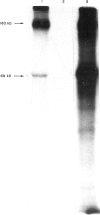Abstract
Applying computer-assisted epitope prediction to the amino-acid sequence of the epidermal growth factor receptor (EGFR), the extracytoplasmic domain EGFR(516-529) was selected as a putative antigenic region. EGFR(516-529) was synthesized on a solid-phase matrix and N-terminally linked to the low mol. wt adjuvant tripalmitoyl-S-glyceryl-cysteinyl-serine (Pam3 Cys-Ser). The conjugation to this B cell and macrophage-activating lipopeptide considerably enhanced the immunogenicity of the EGFR peptide. Using the conjugate Pam3 Cys-Ser-EGFR(516-529), a peptide-specific monoclonal antibody was produced. By flow cytometry and immunoprecipitation the antibody was demonstrated to recognize EGFR on A431 cells, expressing large numbers of EGFR. With this novel approach synthetic immunogens can be prepared which could serve as thermostable synthetic vaccines with great potential in countries where a functional cold chain cannot be maintained.
Full text
PDF





Images in this article
Selected References
These references are in PubMed. This may not be the complete list of references from this article.
- Arnon R., Sela M., Parant M., Chedid L. Antiviral response elicited by a completely synthetic antigen with built-in adjuvanticity. Proc Natl Acad Sci U S A. 1980 Nov;77(11):6769–6772. doi: 10.1073/pnas.77.11.6769. [DOI] [PMC free article] [PubMed] [Google Scholar]
- Bessler W. G., Suhr B., Bühring H. J., Muller C. P., Wiesmüller K. H., Becker G., Jung G. Specific antibodies elicited by antigen covalently linked to a synthetic adjuvant. Immunobiology. 1985 Sep;170(3):239–244. doi: 10.1016/S0171-2985(85)80095-4. [DOI] [PubMed] [Google Scholar]
- Böltz T., Hummel R. P., Tröger W., Rübsamen-Waigmann H., Biesert L., Müller-Lantzsch N., Koch P., Bessler W., Jung G. Distinction between HIV-1 and HIV-2 infection using novel synthetic lipopeptide conjugates as antigens in enzyme immunoassays. J Virol Methods. 1988 Dec;22(2-3):173–182. doi: 10.1016/0166-0934(88)90100-0. [DOI] [PubMed] [Google Scholar]
- Chou P. Y., Fasman G. D. Empirical predictions of protein conformation. Annu Rev Biochem. 1978;47:251–276. doi: 10.1146/annurev.bi.47.070178.001343. [DOI] [PubMed] [Google Scholar]
- Downward J., Yarden Y., Mayes E., Scrace G., Totty N., Stockwell P., Ullrich A., Schlessinger J., Waterfield M. D. Close similarity of epidermal growth factor receptor and v-erb-B oncogene protein sequences. Nature. 1984 Feb 9;307(5951):521–527. doi: 10.1038/307521a0. [DOI] [PubMed] [Google Scholar]
- Garnier J., Osguthorpe D. J., Robson B. Analysis of the accuracy and implications of simple methods for predicting the secondary structure of globular proteins. J Mol Biol. 1978 Mar 25;120(1):97–120. doi: 10.1016/0022-2836(78)90297-8. [DOI] [PubMed] [Google Scholar]
- Jung G. Synthesis and perspectives of new adjuvants and carrier systems for potential application for synthetic vaccines. Ann Sclavo Collana Monogr. 1984;1(2):191–208. [PubMed] [Google Scholar]
- Krishan A. Rapid flow cytofluorometric analysis of mammalian cell cycle by propidium iodide staining. J Cell Biol. 1975 Jul;66(1):188–193. doi: 10.1083/jcb.66.1.188. [DOI] [PMC free article] [PubMed] [Google Scholar]
- Kyte J., Doolittle R. F. A simple method for displaying the hydropathic character of a protein. J Mol Biol. 1982 May 5;157(1):105–132. doi: 10.1016/0022-2836(82)90515-0. [DOI] [PubMed] [Google Scholar]
- Lex A., Wiesmüller K. H., Jung G., Bessler W. G. A synthetic analogue of Escherichia coli lipoprotein, tripalmitoyl pentapeptide, constitutes a potent immune adjuvant. J Immunol. 1986 Oct 15;137(8):2676–2681. [PubMed] [Google Scholar]
- Sweet R. M., Eisenberg D. Correlation of sequence hydrophobicities measures similarity in three-dimensional protein structure. J Mol Biol. 1983 Dec 25;171(4):479–488. doi: 10.1016/0022-2836(83)90041-4. [DOI] [PubMed] [Google Scholar]
- Ullrich A., Coussens L., Hayflick J. S., Dull T. J., Gray A., Tam A. W., Lee J., Yarden Y., Libermann T. A., Schlessinger J. Human epidermal growth factor receptor cDNA sequence and aberrant expression of the amplified gene in A431 epidermoid carcinoma cells. 1984 May 31-Jun 6Nature. 309(5967):418–425. doi: 10.1038/309418a0. [DOI] [PubMed] [Google Scholar]
- Welling G. W., Weijer W. J., van der Zee R., Welling-Wester S. Prediction of sequential antigenic regions in proteins. FEBS Lett. 1985 Sep 2;188(2):215–218. doi: 10.1016/0014-5793(85)80374-4. [DOI] [PubMed] [Google Scholar]
- Wiesmüller K. H., Jung G., Hess G. Novel low-molecular-weight synthetic vaccine against foot-and-mouth disease containing a potent B-cell and macrophage activator. Vaccine. 1989 Feb;7(1):29–33. doi: 10.1016/0264-410x(89)90007-8. [DOI] [PubMed] [Google Scholar]



